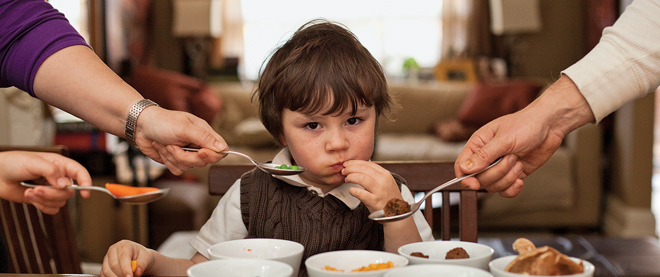Why won’t they eat their vegetables?
An author says heredity and an abundance of taste buds are to blame for picky eaters
Photograph by Andrew Tolson
Share

If cookies are all your child wants for lunch, then author Elizabeth Pantley may be able to reverse the situation. In her new advice book for parents, The No-Cry Picky Eater Solution: Gentle Ways to Encourage Your Child to Eat, Pantley explains the biology and science behind picky eating, and what to do about it.
Picky eating is normal, she notes, affecting about 85 per cent of kids. After interviewing hundreds of parents in Canada, China, Zaire and India, Pantley, a mother of four from Seattle, concludes that picky eating is not the fault of “weak, indulgent parents and stubborn, power-seeking kids.” Biology and genetics are at work. “Studies tell us that if one or both parents were picky eaters as children, chances are their child will be a picky eater, too . . . If you disliked broccoli, fish, or fuzzy foods such as peaches and kiwis, chances are your child will dislike the same sort of foods.”
As for why kids can’t get enough candy, Pantley notes, “a link has been found between the preference for sweet foods and the rate of bone growth. When children are in high-growth periods, their preference for sweet foods is elevated.”
What’s more, babies are born with more taste buds than adults, a biological mechanism that “protects children from eating something rancid or poisonous,” she explains. “As soon as a child detects a sour or bitter flavour, his natural instinct is to spit it out. Unfortunately, the compounds that provide vegetables with their health benefits are in the bitter range, so a child’s aversion to vegetables may be based on his natural instinct.”
“If your baby turns his head away and makes a disgusted face, don’t make him eat any more of the food at that sitting,” she advises. “Give him something else you know he enjoys. This will set the stage for him to be open to trying new foods, since he’ll know you will respect his wishes, and thus he’ll be more likely to feel that eating is a pleasant experience.”
Accept, too, that there will always be foods that your child simply won’t like. Pantley gives the example of her eldest daughter, who “detests even the smell of salmon. So we serve it only when she’s not eating with us.”
Talk to your kids about the nutritional properties of food. But don’t make it a painful lecture, warns Pantley. If your child insists on cookies for lunch, she suggests reading the cookie label out loud and saying, “Okay, if you have two of these cookies, you’re having all of your sugar for the whole day. And you haven’t had any protein, and there’s no dairy or vegetables in these cookies. So what can we put on your plate to fill those spaces?”
Serve vegetables as an appetizer or a first course, urges Pantley, citing a study that found when children were given an ounce of carrots as the first course, their vegetable intake for the entire meal rose by nearly 50 per cent. “The kids not only ate the carrots, but they ate more broccoli, too. The researchers don’t know why this occurred,” she writes. Also, serve two vegetables at dinner “to double the chance that your child will eat at least one of them.”
To parents who worry that their child isn’t eating enough, Pantley writes, “Your child’s stomach is only about the size of [that child’s] clenched fist. A small toddler needs about three tablespoons of meat per day; about four green beans and four tablespoons of rice per serving.”
Introduce new foods when the child is between six months and two years old, she advises. “Begin by putting a tiny bit of the new food on your child’s plate along with regular favourites. Don’t expect him to eat it and don’t make a comment if he pulls it apart, smells it or smashes it. If you’ve displayed the new food on your child’s plate eight to 10 times and he still hasn’t eaten it, then gently encourage him to take just one bite. When he sees it enough times, he’ll eventually try it.”
Also, invent crazy names for foods, such as calling broccoli “magic mini-trees.” “When kids ask what’s for dinner . . . start naming the vegetables first to give them their proper due. If you create fun names, you can help your children view them in a different light.”